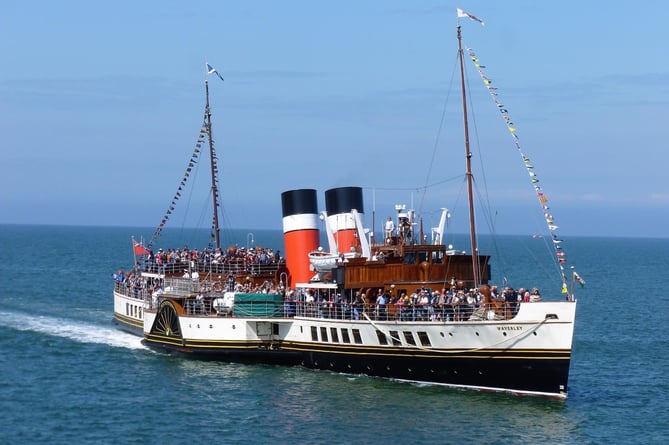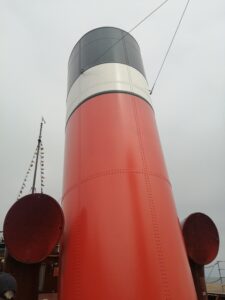 IT was a big shock to discover that it was only a tad under half a century since I first travelled on the world’s last seagoing paddle steamer and classic day excursion ship Waverley, in 1975.
IT was a big shock to discover that it was only a tad under half a century since I first travelled on the world’s last seagoing paddle steamer and classic day excursion ship Waverley, in 1975.
At 77 years old this unique historic vessel, which in my humble opinion is one of the most beautiful operational ships afloat, looks in great shape (far better than me at 66), although she has had a big rebuild with her bottom plates replaced in 2003, which I have yet to undergo.
My most recent reunion with PS Waverley was for a voyage from the River Mersey to Llandudno and return on 25 June 2024, a route made famous by the now defunct Liverpool & North Wales SS Co. but rarely available to the public these days.
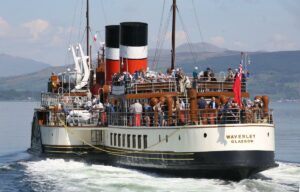 Waverley’s two such voyages this year were blessed with good weather and calm sea conditions which are by no means guaranteed along the North Wales coast in summer.
Waverley’s two such voyages this year were blessed with good weather and calm sea conditions which are by no means guaranteed along the North Wales coast in summer.
On previous visits Waverley departed from Mersey Ferries’ Pier Head Terminal or the adjacent Liverpool Cruise Terminal, but because the latter’s landing stage can only take one ship and was occupied by MS Viking Sky, the paddle steamer was based over the river at the somewhat cluttered Seacombe Landing Stage, on the Wirral side.
Furthermore at the last moment, Mersey Ferries delivered the coup de grace by apparently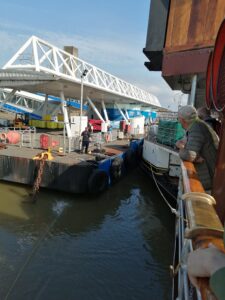 failing to have licensed its Royal Iris of the Mersey, so instead of a spectacular start to the voyage by sailing from the Pier Head ferry terminal across the Mersey to the waiting paddler, passengers had to take the train to Birkenhead Hamilton Square and get bussed to Seacombe Ferry Terminal (not a pretty ride through derelict dockland).
failing to have licensed its Royal Iris of the Mersey, so instead of a spectacular start to the voyage by sailing from the Pier Head ferry terminal across the Mersey to the waiting paddler, passengers had to take the train to Birkenhead Hamilton Square and get bussed to Seacombe Ferry Terminal (not a pretty ride through derelict dockland).
The highest compliments go to Waverley Excursions’ staff for implementing these unforeseen last minute changes the evening before departure and contacting all 700 passengers to ensure they were not left behind waiting for an unlicensed ferry not to arrive.
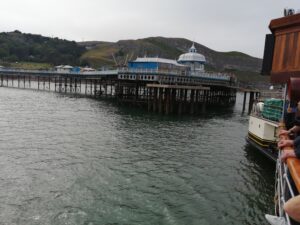 Of course, it’s no good departing on a voyage if you don’t have a destination and we’re so lucky that Llandudno Pier is still intact. God bless its private owners in maintaining the only North Wales pier which can still berth ships, making an ideal three and a half hour sailing time from the Mersey.
Of course, it’s no good departing on a voyage if you don’t have a destination and we’re so lucky that Llandudno Pier is still intact. God bless its private owners in maintaining the only North Wales pier which can still berth ships, making an ideal three and a half hour sailing time from the Mersey.
The good weather was also a blessing as with both sailings sold out passengers could spread over the open decks and down below. Also, as Waverley has a shallow draft dictated by the need to operate in the shallower reaches of her home Clyde waters, she can bounce around in stormy weather.
It was also great to see that the crew are largely Scottish which really adds to the ship’s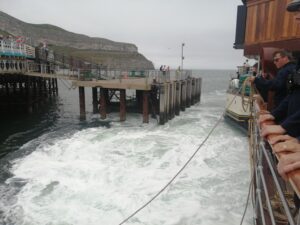 atmosphere. On a previous voyage some years back, the catering crew were mainly east European, glum and inert, who ignored my request for help with a passenger who was suffering serious seasickness.
atmosphere. On a previous voyage some years back, the catering crew were mainly east European, glum and inert, who ignored my request for help with a passenger who was suffering serious seasickness.
One of the glories of Waverley is watching her diagonal triple expansion steam engine, with its three giant pistons sliding up and down and cranks whirling around to propel her two paddle wheels either side of the ship. The main midships passenger passageways have open galleries so you can view this mesmeric sight, the machinery looking as pristine as when it was manufactured by Rankin & Blackmore for her maiden voyage on 16 June 1947.
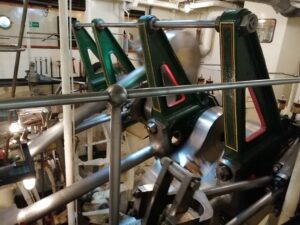 Apparently these galleries were an innovation by the highly inventive Capt Buchanan of Williamson Buchanan’s pre-WWI Clyde excursion steamers who was no slouch about publicity and the means of capturing passengers’ interest.
Apparently these galleries were an innovation by the highly inventive Capt Buchanan of Williamson Buchanan’s pre-WWI Clyde excursion steamers who was no slouch about publicity and the means of capturing passengers’ interest.
This open gallery arrangement also gave rise to that popular male announcement that ‘dad’ was ‘just going to look at the engines’, which was code for a rather longer diversion via the bar.
Waverley is literally a moving museum piece, not just the sole survivor of day tripping excursion paddle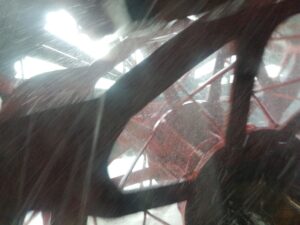 steamers, but of the whole Clyde shipbuilding industry which once dominated the world but now seems incapable of completing two CalMac ferries for the Firth’s inter-island service.
steamers, but of the whole Clyde shipbuilding industry which once dominated the world but now seems incapable of completing two CalMac ferries for the Firth’s inter-island service.
The paddler was built by A&J Inglis at Pointhouse, Glasgow, in 1947, to an outdated, but reliable and well-tested design. She was completed just after WWII (replacing her namesake lost at the Dunkirk evacuation) for her owners, the London & North Eastern Railway.
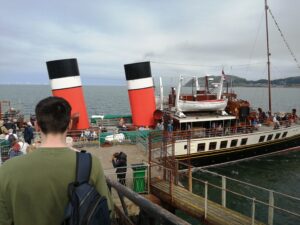 In spite of postwar deprivations of materials and expert manpower, Waverley was delivered on time and in budget unlike today’s CalMac ferries Glen Sannox and Glen Rosa. The pair, built by Ferguson Marine on the Clyde, are six years behind schedule and their cost has ballooned to £400m, four times the original contract. It is said a far better tender from Cammell Laird was rejected simply because the shipyard was in Birkenhead, not Scotland.
In spite of postwar deprivations of materials and expert manpower, Waverley was delivered on time and in budget unlike today’s CalMac ferries Glen Sannox and Glen Rosa. The pair, built by Ferguson Marine on the Clyde, are six years behind schedule and their cost has ballooned to £400m, four times the original contract. It is said a far better tender from Cammell Laird was rejected simply because the shipyard was in Birkenhead, not Scotland.
Meantime A&J Inglis’s shipyard, which became a subsidiary of Harland & Wolff of Belfast, was closed in 1962. The shipyard is now the site of Glasgow’s Riverside Museum, celebrating Scotland’s stupendous transport past. That’s progress folks!
My only gripe is that Waverley is only operating from the Mersey for a couple of days each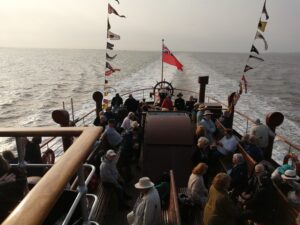 year. Obviously we should be truly grateful for this, but can she stay longer next year please?
year. Obviously we should be truly grateful for this, but can she stay longer next year please?
- PS Waverley operates cruises around the UK, including North Wales and her Clyde home waters. From 27 September to 13 October she will based in London for her Thames cruising season.
- Further information: Waverley Excursions, tel: 0141 243 2224; 36 Lancefield Quay, Glasgow, G3 8HA.
- Website: https://waverleyexcursions.co.uk

